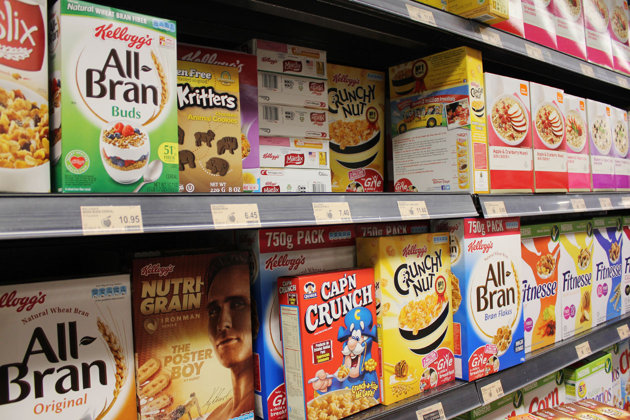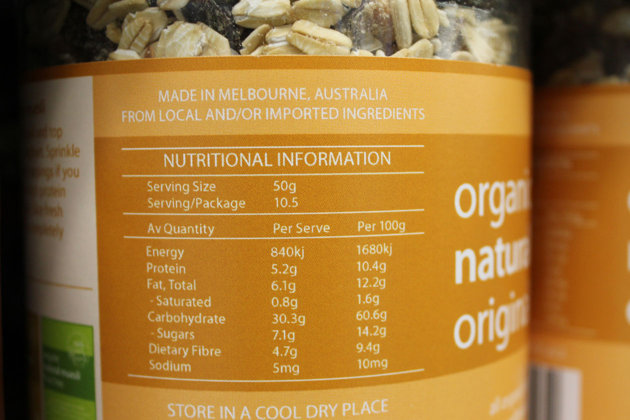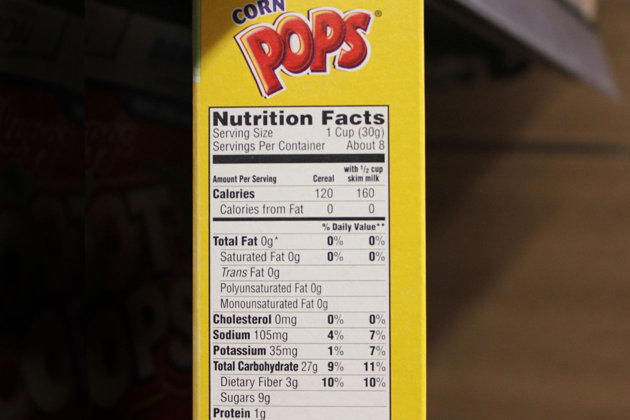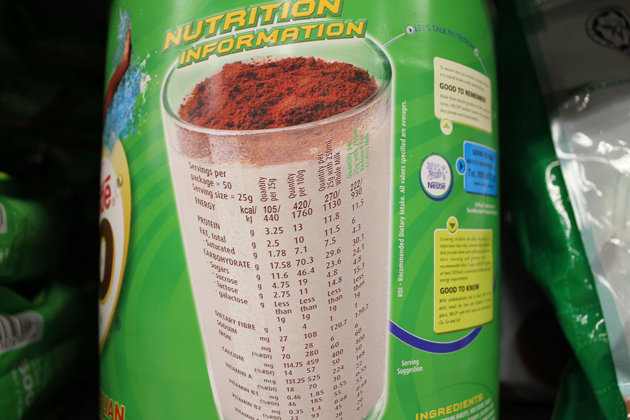
Decoding Nutritional Labels
By Jade Hu (Images by Joanna Goh @ Makansutra) - Friday, Mar 28, 2014
Time to go food shopping. You go to the aisle, grab your box of cereals, look at the label and you squint and stare down the fine print. There’s a lot, perhaps too much, to read. You give up and toss the box into your trolley. Onward to the next item. You resolve to read the label later at home but somehow never got around to doing it.
Gone are the days when we make our food from scratch and you know that chicken stock is made of, well…chicken. Those days are gone, these days, we can’t be entirely sure of what goes into our food. These labels are our buddies, and if they can talk to us, they become our bosom buddies. When you read “0.7g of protein”, are you getting exactly that much?
We cut to the core and give you the gist.
Serving Size
This suggests how much a typical person would eat, but not everyone eats the same serving size. Here it says one serving is 50g. If you normally eat 100g of this cereal, multiply by two the amount of calories, nutrients, fats, sugars, sodium etc… as you go down the label.
Calories / Energy
Calories tell you how much energy you get from eating one serving of food. The unit is kilocalorie (kcal). For those who are doing low to moderate physical activity or mostly have a sedentary lifestyle, the average male needs around 2000kcal per day, while an average woman needs about 1800kcal per day.

Calories from Fat
This is the number of calories derived from fat. You can tell the amount of fat from this. If you ate two slices of pizza, each containing 350 calories with 100 calories from fat, this means that from the 700 calories you ate, 200 calories is from fat. What’s a reasonable amount to take? The Health Promotion Board recommends that total fat should be limited to 25-30% of total calorie intake, of which less than 10% is from saturated fat.

Carbohydrates
This is the component in food that impacts blood sugar the most. That’s because 90% of it breaks down into simple sugars (glucose) and foods that contain a high amount of carbohydrates (or carbs) will cause a huge spike in blood sugar.
A recommended amount to eat, on a 2,000 calorie diet, is 250 grams of complex carbs – found in pasta, breads and starchy foods. As opposed to complex carbs, simple carbs such as fruit juices and milk break down into sugars much faster and cause the blood sugar to spike. This is one of the reasons why those with diabetes need to watch out for high-carb foods.

Nutrients
The key ones would be vitamins, protein, dietary fibre, iron and calcium. Fats, cholesterol, sodium and sugars are not all bad – you just have to know which ones are good. Protein This section tells you how much protein you consume in one serving of food. A recommended daily amount that an average male between 30 to 60 years old should ingest is 68g, while his female counterpart would need 58g.
Fats
“Total Fat” is not total bad. The bad guys are the saturated and trans-fats, which includes hydrogenated fats. The good guys are Omega-3 (found in fish, seeds and nuts), and monounsaturated and polyunsaturated fats. When it comes to fats, you want a mono-poly of the unsaturated types.
Cholesterol
LDL is bad cholesterol, HDL is good cholesterol. Remember: L for Lousy, H for Happy. If it is not stated, it’s always safe to go low and easy here.
Dietary Fibre
Often we don’t take enough dietary fibre so this is something you can look to eat more of.
Vitamins and Minerals
Look out for Vitamin A, B, C, E, K, and minerals such as potassium, calcium, phosphorus etc. These are our friends, unless you have any pre-existing conditions that suggest you should watch out for them. Check with your doctor.
Sodium
Basically means salt. There is often a lot of sodium in processed foods such as tinned sardines, baked beans, pasta sauces and canned meats. The advice here is to go easy on sodium.
Sugars
This is the amount of sugar you get from one serving of food. You usually take in more than what’s written here. That’s because as you digest your food, some of the carbohydrates will also break down to form simple sugars, which will add to the amount of sugars here. Not all sugars are artificial or added – some sugars in fruit (fructose) and milk (lactose) are naturally occurring. If you are mindful about consuming added sugars, watch out for names like high fructose corn syrup, dextrose, maltrose, maple syrup, cane sugar etc.
Recommended Daily Allowance (RDA)
According to Singapore’s Health Promotion Board (HPB) website, this refers to the recommended daily levels of nutrients to meet the needs of nearly all healthy individuals in a particular age and gender group. For example, an adult between ages 19 and 50, the recommendation is 800mg of calcium a day. Since an average glass of milk contains around 300mg of calcium, you’d have to take more than that to hit the RDA for calcium.
Percent Daily Value (% DV)
This is the percentage of nutrients you get from one serving of food, based on a 2,000-calorie diet – a nutrient guide by the U.S National Academy of Sciences. Looking at this tells you whether there is a lot or very little of a particular nutrient in a food item. This figure is extremely useful for comparing between two food items as you don’t have to do any further calculations. As a quick guide, 5% or less means low nutrient content, whereas 20% or more indicates high nutrient content.
Nutrient Claims
Some products claim to be high-fibre or low-fat. In order to label a claim, it must pass through three rounds: meet the guideline amount, declare accurately, but in the end the analysed amount must be 80% of the guideline amount. This means that for a box of cornflakes to claim as “high in fibre”, the actual amount of dietary fibre needs to meet the minimum amount (equal or more than 6% per 100g), and cannot be more than 20% of what is written, or else it will not pass the ‘test’.
Conversely, if the label on a carton of milk claims to be “low fat”, the fat content cannot be more than the maximum allowed (equal or less than 3% per 100g) and cannot be more than 20% of what is written.



